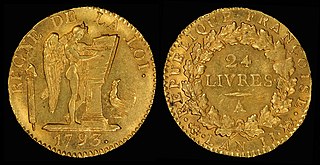Skojec was a medieval central European unit of account as well as a unit of mass. It was also used as a unit of currency. 1 skojec was equal to 1/24 of a grzywna.

The grzywna was a measure of weight, mainly for silver, commonly used throughout medieval central and eastern Europe, particularly in the Kingdom of Poland and Kingdom of Bohemia.
1 skojec = 30 pfennigs
1 wiardunek = 6 skojecs
1 skojec = 2 groschen
The pfennig or penny is a former German coin or note, which was official currency from the 9th century until the introduction of the euro in 2002. While a valuable coin during the Middle Ages, it lost its value through the years and was the minor coin of the Mark currencies in the German Reich, West and East Germany, and the reunified Germany until the introduction of the euro. Pfennig was also the name of the subunit of the Danzig mark (1922–1923) and the Danzig gulden (1923–1939) in the Free City of Danzig.
The Wiardunek was a Mediaeval Central European unit of mass most widely used in Poland and Germany. Wiardunek was also used as a unit of account, and as a such as commodity money.
Groschen was the name for a silver coin used in various states of the Holy Roman Empire.
The etymology of the word skojec derives from the word skot which in old Polish described cattle; cattle were used as the reference unit of exchange since at least the time of ancient Greece, as there are references in the Iliad to a suit of armor costing 9 oxen. Athenian lawgiver Draco, when establishing his laws in 621 BCE, defined all the fines in terms of how many cattle must be paid. The Latin word for money, pecunia, is proof that Romans always saw cattle (pecus) as the source of wealth. In time, a slab of copper with an imprint of an ox became equivalent to the worth of the animal. In India, the word rupia means both cattle and money. Similarly, in Poland skot meant cattle and its extension skojec described money. [1]

Cattle—colloquially cows—are the most common type of large domesticated ungulates. They are a prominent modern member of the subfamily Bovinae, are the most widespread species of the genus Bos, and are most commonly classified collectively as Bos taurus.

Ancient Greece was a civilization belonging to a period of Greek history from the Greek Dark Ages of the 12th–9th centuries BC to the end of antiquity. Immediately following this period was the beginning of the Early Middle Ages and the Byzantine era. Roughly three centuries after the Late Bronze Age collapse of Mycenaean Greece, Greek urban poleis began to form in the 8th century BC, ushering in the Archaic period and colonization of the Mediterranean Basin. This was followed by the period of Classical Greece, an era that began with the Greco-Persian Wars, lasting from the 5th to 4th centuries BC. Due to the conquests by Alexander the Great of Macedon, Hellenistic civilization flourished from Central Asia to the western end of the Mediterranean Sea. The Hellenistic period came to an end with the conquests and annexations of the eastern Mediterranean world by the Roman Republic, which established the Roman province of Macedonia in Roman Greece, and later the province of Achaea during the Roman Empire.

The Iliad is an ancient Greek epic poem in dactylic hexameter, traditionally attributed to Homer. Set during the Trojan War, the ten-year siege of the city of Troy (Ilium) by a coalition of Greek states, it tells of the battles and events during the weeks of a quarrel between King Agamemnon and the warrior Achilles.







